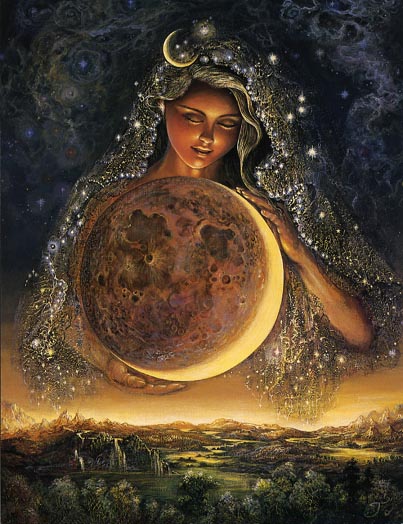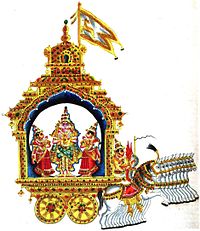


Rough Notes:
List of lunar deities
|
This article needs additional citations for verification. Please help improve this article by adding citations to reliable sources. Unsourced material may be challenged and removed. (July 2009) (Learn how and when to remove this template message)
|
The Hindu Chandra, riding his celestial chariot.
In mythology, a lunar deity is a god or goddess associated with or symbolizing the moon. These deities can have a variety of functions and traditions depending upon the culture, but they are often related. Some form of moon worship can be found in most ancient religions.
Contents
[hide]
Moon in religion and mythology[edit]
The monthly cycle of the moon, in contrast to the annual cycle of the sun's path, has been implicitly linked to women's menstrual cycles by many cultures, as evident in the links between the words for menstruation and for moon in many resultant languages.[1] Many of the most well-known mythologies feature female lunar deities, such as the Greek goddesses Phoebe, Artemis, Selene, and Hecate as well as the Chinese goddess Chang'e.
Male lunar gods are also frequent, such as Sin of the Mesopotamians, Mani of the Germanic tribes, and the Japanese god Tsukuyomi. These cultures usually featured female Sun goddesses. There are also many lunar deities that were prevalent in Greek and Egyptian civilizations. For example, Ibis and Chonsu of Thebes were both lunar deities. Thoth was also a lunar deity, but his character is considerably more complex than Ibis and Chonsu.[2] Set represented the Moon in the Egyptian Calendar of Lucky and Unlucky Days of papyrus Cairo 86637.[3]
The original Proto-Indo-European lunar deity appears to have been a male god.[4] Several goddesses, like Artemis or Hecate, did not originally have lunar aspects, and only acquired them late in antiquity, due to syncretism with Selene/Luna, the de facto Greco-Latin lunar deity. In traditions with male gods, there is little evidence of such syncretism, though the Greco-Roman Hermes has been equated with male Egyptian lunar gods like Thoth. In Greece proper, remnants of male moon gods are also seen with Menelaus.
Also of significance is that many religions and societies are oriented chronologically by the Moon as opposed to the sun. One common example is Hinduism in which the word Chandra means Moon and has religious significance during many Hindu festivals (e.g. Karwa Chauth, Sankasht Chaturthi and during the eclipses).
The moon is also worshipped in witchcraft, both in its modern form and in Medieval times, for example, in the cult of Madonna Oriente. It features prominently in art and literature and also the purported influence of the moon in human affairs remains a feature of astrology and theology.
The list[edit]
Near East[edit]
- God Ta'lab (Arabian mythology)
- God Wadd (Minaean mythology)
- Goddess Nikkal (Canaanite mythology)
- God Yarikh (Canaanite mythology)
- God Baal-hamon (Carthaginian religion)
- God Napir (Elamite mythology)
- God Kaskuh (Hittite mythology)
- God Kusuh (Hurrian mythology)
- God Sin (Mesopotamian mythology)
- God Aglibol (Palmarene mythology)
- God Men (Phrygian mythology)
- Goddess Selardi (Urartian mythology)
Africa[edit]
- Goddess Ala (Igbo mythology)
- Goddess Gleti (Dahomean mythology)
- Goddess Mawu (Dahomean mythology)
- God Iah (Egyptian mythology)
- God Khonsu (Egyptian mythology)
- God Osiris (Egyptian mythology)[5]
- God Thoth (Egyptian mythology)
- Goddess Neith (Egyptian Mythology)
- Goddess Isis (Egyptian Mythology)
- Goddess Nephthys (Egyptian Mythology)
- God Arebati (Mbuti mythology)[citation needed]
- Goddess Tpollisia (Mbuti mythology)[citation needed]
- Goddess Arawa (Pokot mythology)[citation needed]
- God Kalfu (Vodun mythology)
- Goddess Yemaya (Yoruba mythology)
- Goddess Jezanna ("Zimbabwean" mythology)[citation needed]
Europe[edit]
- Goddess Kazza (Arturian mythology)
- Goddess Ilargi (Basque mythology)
- Goddess Artume (Etruscan mythology)
- Goddess Losna (Etruscan mythology)
- Goddess Kuu (Finnish mythology)
- Goddess Achelois (Greek mythology)
- Goddess Phoebe (Greek mythology)
- Goddess Artemis (Greek mythology)
- Goddess Selene (Greek mythology)
- Goddess Hecate (Greek mythology)
- God Máni (Norse mythology)
- God Elatha (Irish Mythology)
- God Meness (Latvian mythology)
- Goddess Ataegina (Lusitanian mythology)
- Goddess Diana (Roman mythology)
- Goddess Luna (Roman mythology)
- Goddess Trivia (Roman mythology)
- Goddess Mano (Sami mythology)
- God Jarilo (Slavic mythology)
- Goddess Bendis (Thracian mythology)
- Goddess Arianrhod (Welsh mythology)
Asia[edit]
- Goddess Chup Kamui (Ainu mythology)
- Goddess Chang'e (Chinese mythology)
- God Wu Gang (Chinese mythology)
- Goddess Su'e (Chinese mythology)
- Goddess Han Ying (Chinese mythology)
- Goddess Queen Jiang (Chinese mythology)
- Goddess Chang Xi (Chinese mythology)
- God Jie Lin (Chinese mythology)
- Goddess Anumati (Hindu mythology)
- Goddess Raka (Hindu mythology)
- Goddess Kuhu (Hindu mythology)
- Goddess Sinhivala (Hindu mythology)
- God Chandra or 'Indu' (Hindu mythology)
- Goddess Ratih (Indonesian mythology)
- Goddess Silewe Nazarate (Indonesian mythology)
- God Tsukuyomi (Japanese mythology)
- Goddess Dae-Soon (Korean mythology)[citation needed]
- Goddess Mayari (Philippine mythology)
- God Libulan (Philippine mythology)[citation needed]
- God Bulan (Philippine mythology)[citation needed]
- Goddess Haliya (Philippine mythology)
- God Ay Ata (Turkic mythology)
Oceania[edit]
- God Bahloo (Australian Aboriginal mythology)
- Goddess Lona (Hawaiian mythology)
- God Kidili (Mandjindja mythology)
- God Avatea (Polynesian mythology)
- God Fati (Polynesian mythology)
- Goddess Hina (Polynesian mythology)
- Goddess Mahina (Polynesian mythology)
- God Marama (Polynesian mythology)
- God Ngalindi (Yolngu mythology)
Mesoamerica[edit]
- Goddess Coyolxauhqui (Aztec mythology)
- Goddess Metztli (Aztec mythology)
- God Tecciztecatl see Metztli (Aztec mythology)
- Goddess and god Awilix (K'iche' Maya mythology)
- God Ixbalanque (Maya mythology)
- Maya moon goddess (Maya mythology)
South America[edit]
- Goddess Huitaca (Muisca mythology)
- Goddess Chía (Muisca mythology)
- God Abaangui (Guarani mythology)
- God Coniraya (Incan mythology)
- Goddess Mama Killa (Incan mythology)
- Goddess Ka-Ata-Killa (Incan mythology)
- Goddess Jaci (Tupi mythology)[citation needed]
North America[edit]
- Goddess Menily (Cahuilla mythology)[citation needed]
- God Muuya (Hopi mythology)[citation needed]
- God Alignak (Inuit mythology)
- God Igaluk (Inuit mythology)
- God Tarqiup Inua (Inuit mythology)
- God Pah (Pawnee mythology)[citation needed]
- Goddess Hanwi (Lakota mythology)[citation needed]
See also[edit]
- Great Goddess
- Man in the Moon
- Moon idol
- Moon rabbit
- Nature worship
- Solar deity
- The White Goddess
- Triple Goddess
References[edit]
| Wikimedia Commons has media related to Lunar deities. |
- Jump up^ Harding, Esther M., 'Woman's Mysteries: Ancient and Modern', London: Rider, 1971, p. 24.
- Jump up^ Thoth, the Hermes of Egypt: a study of some aspects of theological thought in ancient Egypt, page 75
- Jump up^ Jetsu, L.; Porceddu, S. (2015). "Shifting Milestones of Natural Sciences: The Ancient Egyptian Discovery of Algol's Period Confirmed". PLOS ONE. 10 (12): e.0144140 (23pp). doi:10.1371/journal.pone.0144140.
- Jump up^ Dexter, Miriam Robbins. Proto-Indo-European Sun Maidens and Gods of the Moon. Mankind Quarterly 25:1 & 2 (Fall/Winter, 1984), pp. 137–144.
- Jump up^ S. Quirke and A.J. Spencer, The British Museum Book of Ancient Egypt. London, The British Museum Press, 1992
